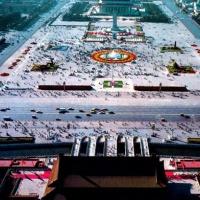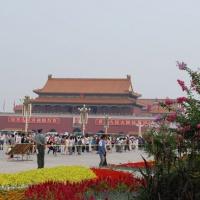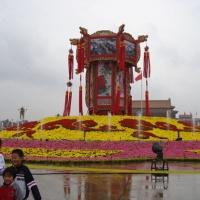 The Tiananmen Square was first designed and built in 1651. It was extended to its present size (four times its original size) in 1958. It covers an area of 100 acres and can hold at least 1 million people, which makes it the largest public square in the world. It is the heart of Beijing and the Changan Avenue is leading onto it. The square was once a gathering place and the location of government offices in the imperial days, but today it is a place, if the weather is conducive, for people to lounge around in the evening, take photos, and a place to fly decorated kites - a striking sight. Surrounding or pockmarking the Tiananmen Square are the monuments of China past and present: Tiananmen Gate, the Museum of Chinese History and Museum of the Chinese Revolution, the Great Hall of the People, Qianmen Gate, the Mao Mausoleum and the Monument to the People's Heroes.
The Tiananmen Square was first designed and built in 1651. It was extended to its present size (four times its original size) in 1958. It covers an area of 100 acres and can hold at least 1 million people, which makes it the largest public square in the world. It is the heart of Beijing and the Changan Avenue is leading onto it. The square was once a gathering place and the location of government offices in the imperial days, but today it is a place, if the weather is conducive, for people to lounge around in the evening, take photos, and a place to fly decorated kites - a striking sight. Surrounding or pockmarking the Tiananmen Square are the monuments of China past and present: Tiananmen Gate, the Museum of Chinese History and Museum of the Chinese Revolution, the Great Hall of the People, Qianmen Gate, the Mao Mausoleum and the Monument to the People's Heroes.
Tiananmen Gate
Tiananmen Gate or Tiananmen, literally the "Gate of Heavenly Peace", is a national symbol of China, which pops up on everything from airline tickets to policemen's caps.
 Located along the northern edge of Tiananmen Square, it was built in the 15th century and restored in the 17th century, 34.7 meters in height. From imperial days Tiananmen functioned as a rostrum for dealing with or proclaiming to the assembled masses. There are five doors to the gate and in front of it is seven bridges spanning a stream - each of these bridges had restricted use, and only the emperor could use the central door and bridge. It was from the gate that Mao proclaimed the People's Republic on 1 October 1949 and there have been a few alterations since then; the dominating feature is the gigantic portrait of Mao in the central gate, the required backdrop for any photo the Chinese take of themselves at the gate.
Located along the northern edge of Tiananmen Square, it was built in the 15th century and restored in the 17th century, 34.7 meters in height. From imperial days Tiananmen functioned as a rostrum for dealing with or proclaiming to the assembled masses. There are five doors to the gate and in front of it is seven bridges spanning a stream - each of these bridges had restricted use, and only the emperor could use the central door and bridge. It was from the gate that Mao proclaimed the People's Republic on 1 October 1949 and there have been a few alterations since then; the dominating feature is the gigantic portrait of Mao in the central gate, the required backdrop for any photo the Chinese take of themselves at the gate.
To the left of the portrait is a slogan 'Long Live the People's Republic of China' and to the right 'Long Live the Unity of the Peoples of the World', and both slogans are written in simplified Chinese instead of traditional Chinese characters. Grandstands with a capacity of 20,000 dignitaries were added for reviewing purposes.
Photography is big at Tiananmen-the Chinese aspire to visiting the heart of the nation almost like the Muslims aspire to visiting Mecca and Chinese schoolchildren grow up singing 'I Love Tiananmen'. If you venture a little way into the Forbidden through Tiananmen you will find all kinds of bizarre photo-props such as cardboard cut-outs of opera stars or a car provided by the state.
For over 500 years, common people had been forbidden to close the Beijing Tiananmen Gate until it was open to the world tourists in 1987. Today, thousands upon thousands of people are proud of mounting this great Chinese symbol gate.
 Museum of Chinese History & Museum of the Chinese Revolution
Museum of Chinese History & Museum of the Chinese Revolution
Both are located on the east side of Tiananmen Square. The History Museum has artifacts and cultural relics from Day 1 to 1919, subdivided into areas of primitive communal man, slavery, feudalism and capitalism/imperialism. It also houses many ancient weapons, inventions and musical instruments.
The Museum of the Revolution is split into five sections: the first civil war (1924-27); the second civil war (1927-1937); resistance against Japan (1937-45) and the third civil war (1945-49). Students often visit here escorted by their teachers; and PLA soldiers are occasionally taken through the museums on tours; they snap to attention, open portable chairs and sit down in unison for explanations of each section.
Monument to the People's Heroes
On the southern side of Tiananmen, this monument was completed in 1958 and stands on the site of the old Outer Palace Gate. The36 meter obelisk, made of Qingdao granite, bears bas relief carvings of key revolutionary events as well as appropriate calligraphy from Mao Zedong and Zhou En-lai.
Mao Zedong Mausoleum
Behind the Monument to the People's Heroes stands this giant mausoleum built to house the body of Chairman Mao (Only the upper part of the body is visible - draped in a red flag and encased in a crystal sarcophagus.). It was constructed over a period of ten months in 1976-77. At the end of 1983 the mausoleum was reopened as a museum with exhibitions on the lives of Zhou En-lai, Zhu De, Mao, and Liu Shao-qi. Mao's body still remains in its place.
 Qianmen Gate
Qianmen Gate
The Zhengyangmen Gate is commonly referred to as Qianmen Gate (or Front Gate). Situated on the southern edge of the Tiananmen Square, it is on the few old gates left, and a great landmark to get around by. It guarded the wall-division between the ancient Inner City and the outer suburban zone, and dates back to the reign of Emperor Yong-le in the 15th century. But most Beijing people also regard Dazalan (a famous shopping street near the Zhengyangmen Gate) and the jewelry shops near the gate as the Qianmen Gate.
Great Hall of the People
Also called the people's Great Hall, it is the venue of the National Peoples' Congress. You can get into this building - for a price. You tramp through the halls of power, many of them name after provinces and regions of China and decorated appropriately; you get to see the 5000-seat banquet room where Nixon dined in 1972 and the 10,000-seat auditorium with the familiar red star embedded in a galaxy of lights in the ceiling. There's a sort of museum-like atmosphere in the Great Hall, with objects and art donated by the provinces, and snack bar and restaurant at the end of a brief escorted tour. The Hall was completed over a 10-month period in 1958-59.
